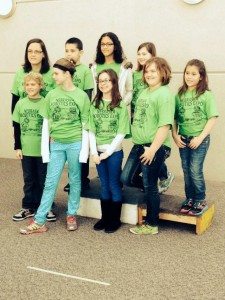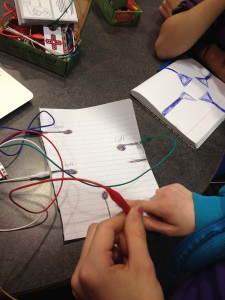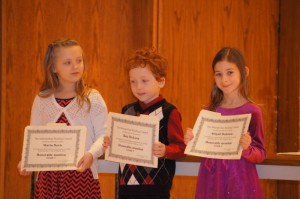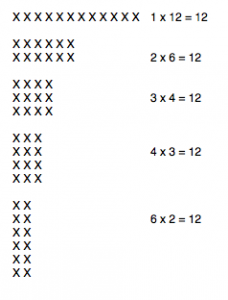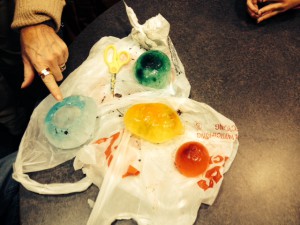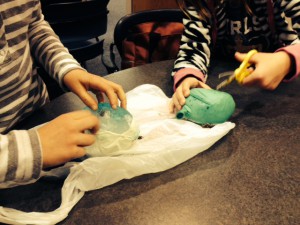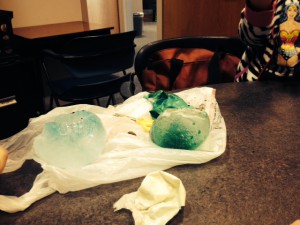Do you have writer’s block? Having a hard time coming up with an idea for your “Choose Your Own Adventure” story? Click on the website below to help guide you in the process.
Category Archives: Spady Blog
Explain Everything
Although I like to recommend free apps, Explain Everything is one that I feel is well worth the money. At $2.99, it allows students to explain their thinking as they are completing a variety of tasks. As a former math teacher, I was good at having students complete problems on paper, but I didn’t have them EXPLAIN what they were doing. Explain Everything is the perfect app to check for understanding as kids explain a process.
In the Fraction-Decimal-Percent Video, students are describing one method for converting a fraction to a decimal and percent.
FracDecPer Video
I also had my 1st graders use Explain Everything. They typed a few rhyming words, made a sentence and then illustrated it.
What are some ideas you have for using Explain Everything? Leave a comment!
The Chemistry of Cookies
Just when you thought science couldn’t get any more exciting!
This TEDEd video by Stephanie Warren explains basic chemistry principles through the process of baking cookies – from how the dough spreads out to how the oven temperatures kill salmonella. Grab a glass of milk and a couple cookies and dive in to the science of cooking!
When you’re finished watching the video, complete the questions on the Google Form.
Video Link: http://ed.ted.com/lessons/the-chemistry-of-cookies-stephanie-warren
cookie picture taken from pdclipart.org
Worldmapper
![]() Worldmapper is a collection of world maps based on various subjects from meat imports to cholera deaths to absolute poverty. As a young student, I remember looking up statistics about countries in various books. However, without access to technology, much of this information was meaningless to me and it was difficult to make connections. Today’s students have access to tools like Worldmapper and Google Earth, which brings the information to a whole new level!
Worldmapper is a collection of world maps based on various subjects from meat imports to cholera deaths to absolute poverty. As a young student, I remember looking up statistics about countries in various books. However, without access to technology, much of this information was meaningless to me and it was difficult to make connections. Today’s students have access to tools like Worldmapper and Google Earth, which brings the information to a whole new level!
I recently worked with some 4th graders and showed them various maps on Worldmapper. After looking at each map, I had them write down a question about the map. This led to some interesting discussions and connections. Below are just a few of the maps we explored and the questions students wrote. Check out Worldmapper and leave a comment about a map you found interesting!
Map # 1 Meat Imports: http://www.worldmapper.org/display.php?selected=50
- How do they choose the shape of the countries?
Map # 2: Fruit Imports: http://www.worldmapper.org/display.php?selected=42
- To be so big, how much fruit does Europe import?
Map # 3: Vegetables Consumed: http://www.worldmapper.org/display.php?selected=124
- What is the most eaten food in china?
Map # 4 Poor Water: http://www.worldmapper.org/display.php?selected=186
- What is the disease that is mostly caught through water?
Map # 5: Cholera Cases: http://www.worldmapper.org/display.php?selected=231
- What is the usual age one gets cholera?
Map # 6: Yellow Fever: http://www.worldmapper.org/display.php?selected=236
- Where would you get a yellow fever vaccination?
- How much does it cost and how hard would it be to get to people in Northern Africa?
Map # 7: Absolute Poverty: http://www.worldmapper.org/display.php?selected=180
- What would you most likely buy when you live on two dollars a day?
Innovators at Westgate
Third quarter was full of innovation at Westgate! On Feb. 22, a group of students participated in the 2014 Robotics Expo at Strategic Air and Space Museum. The students competed in various events that required problem solving, teamwork, and critical thinking. Fourth graders Alex and Caleb entered the documentation competition and earned first place for their innovative ideas. Alex designed a customizable classroom chair and Caleb came up with an innovative way to keep his clothes organized.
In March, Westgate received grant funds from the Kids in Need Foundation. We purchased nine Makey Makeys and the kids have been having a blast! Check out the videos and pictures!
Makey Makey Video
Although we missed the deadline, Google hosts an annual competition called Doddle 4 Google and sixth grader Tera came up with a great design!
First graders Abigail and Marin earned honors from the Metropolitan Reading Council for the stories they wrote about a new and unusual superhero.
Great job Gators! Continue to think creatively, be imaginative and innovative!
Math Curse
I’ve been reading The Math Curse by John Scieska + Lane Smith to my first grade group and I continue to be amazed at what their young minds can absorb! If you’re not familiar with the book, here is a link to a video of the book being read. Here is another link to a condensed version of the book (more in movie form). I have read this book to all ages and there’s really something for everyone in here…no matter what your math background. Here are the things I worked on with the 1st graders:
Fibonacci’s Sequence: 1, 1, 2, 3, 5, 8, 13, 21…
- I put the sequence on the board and within a minute, the first graders were able to figure out the pattern. What are the next 3 numbers in this sequence? What would the first 10 terms in the sequence be if Fibonacci’s sequence started with 2 fours?
Gallons-Quarts-Pints-Cups
- The graphic below is often used to teach volume conversions. There are 4 quarts in a gallon, 2 pints in a quart, and 2 cups in a pint. Having this visual makes it easy to answer other conversion questions. How many pints are in a gallon? How many cups in a gallon? How many quarts are in a half gallon?
Arrays
- Instead of 24 kids in the class, the first graders helped figure out seating arrangements for 12 kids. They easily came up with 1 row of 12, 2 rows of 6, and so on. That made it really easy to introduce multiplication. We also had fun counting how many ears, fingers, eyes, etc. in the classroom. As an extension, I asked questions like: What is the number eyes in the classroom take away the number of noses? What is the number of fingers in the classroom plus the number of arms?
The students’ homework is to make up an everyday math problem so we can create a book similar to The Math Curse. Leave a comment with a math problem that you made up and it just might make it into our book!
Cool New Beef
Guest blog post by Alex
Click Here for the Talking Cow
What if you could get a hamburger without any cows being harmed in the process?
Scientists at Maastricht University in the Netherlands did just that. How you ask? They took some cow muscle stem cells and fed them until they multiplied. Eventually there was enough to make hamburger patty. They added some beet juice to give it color and some bread crumbs to give it texture. Want to know how it tasted? You’ll have to find out by reading “Meet the New Meet” by Stephen Ornes.
https://student.societyforscience.org/article/meet-new-meat?mode=topic&context=39
Wonders of Water Follow-Up
Wonders of Water

I attended a professional development workshop over 10 years ago and this apple demonstration has always stuck with me. The presenter used an apple to represent the earth and then cut one-quarter out. She explained three-quarters (75%) of our earth is water. This of course means one-quarter is land. She went on to cut that quarter slice of apple in half explaining that half of the land on earth is inhabitable. What types of places and location on earth are inhabitable? One final step was to take that 1/2 of 1/4 (What fraction is that?) and peel off the skin. The skin represented the land that was used for farming leaving the rest to represent where all the world’s people live.
This apple demonstration could be used with any grade level to discuss/research a variety of topics. The 1st graders and I used it as a way to talk about water. I made them a water droplet notebook where they took notes on lakes, rivers, seas, and oceans. We talked about the Pacific and Atlantic Ocean, the Great Lakes, the Mississippi and Missouri River, and even learned how to spell Lake Kabetogama. Have you been to a lake/river/ocean lately? Leave us a comment. We’d love to hear about it!
Before our time was over, we talked about the freezing and boiling point of water. We looked at Omaha’s temperatures for the week and talked about whether water would freeze based on the temperatures listed. We filled 4 balloons with water and even added a little food coloring. The students made a hypothesis on what would happen to the water balloons if we placed them outside. What do you think will happen? The balloons are currently outside in a secret hiding place. Check back in a couple days to see what we discovered!
Programming in the Primary Grades
This weekend I went to Kansas City with my 10 and 6-year-old to attend a Coder Dojo. It was really neat to see kids of all ages actively engaged in programming! Needless to say, I’ve been on a programming kick all day!
First graders started out using Daisy the Dinosaur on the iPad and learned how to use simple commands like move, jump, and spin to make Daisy the Dino complete various challenges. This app is free in the iTunes store and can be downloaded here: https://itunes.apple.com/us/app/daisy-the-dinosaur/id490514278?mt=8
 Hopscotch is another free app. You can download it here: https://itunes.apple.com/us/app/hopscotch-coding-for-kids/id617098629?mt=8 Here’s a quick video clip: 1stGradeProgramming
Hopscotch is another free app. You can download it here: https://itunes.apple.com/us/app/hopscotch-coding-for-kids/id617098629?mt=8 Here’s a quick video clip: 1stGradeProgramming
The 4th and 6th grade students learned some basic if/then programming using spreadsheets. See if you can understand what this means:
=IF(B2=72,”Awesome”,”Try Again”) Translation: If what you type in cell B2 is 78, then print “Awesome!” Otherwise, print “Try Again.” The students had fun making up problems and then testing their programming skills using a spreadsheet.
Translation: If what you type in cell B2 is 78, then print “Awesome!” Otherwise, print “Try Again.” The students had fun making up problems and then testing their programming skills using a spreadsheet.
Next, a 5th grader led a group of students in programming polygons using Java Script. He used Khan Academy and did a nice job explaining each step and having the students write notes in their notebook. These students will take turns teaching each other throughout the coming weeks.
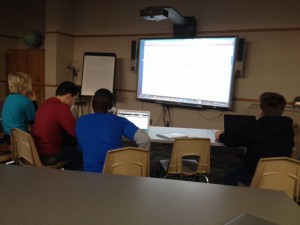 In the Did You Know 3.0 video, it talks about preparing students for a future filled with jobs that do not currently exist, using technologies that haven’t been invented, in order to solve problems we don’t even know are problems yet. In his TEDx Talk, Mitch Resnick talks about young people today having lots of experience and lots of familiarity with interacting with new technologies, but a lot less so of creating new technologies and expressing themselves with new technologies. I believe teaching kids to code is just one way to provide students with authentic and engaging problems while teaching them to communicate, problem solve, and persevere.
In the Did You Know 3.0 video, it talks about preparing students for a future filled with jobs that do not currently exist, using technologies that haven’t been invented, in order to solve problems we don’t even know are problems yet. In his TEDx Talk, Mitch Resnick talks about young people today having lots of experience and lots of familiarity with interacting with new technologies, but a lot less so of creating new technologies and expressing themselves with new technologies. I believe teaching kids to code is just one way to provide students with authentic and engaging problems while teaching them to communicate, problem solve, and persevere.
What are your thoughts about teaching kids to code? Leave us a comment!

